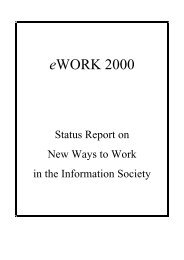Proceedings of 8th European Assembly on telework (Telework2001)
Proceedings of 8th European Assembly on telework (Telework2001)
Proceedings of 8th European Assembly on telework (Telework2001)
You also want an ePaper? Increase the reach of your titles
YUMPU automatically turns print PDFs into web optimized ePapers that Google loves.
42But even so, <strong>on</strong> average the developments mean that individuals by and large will have moreindependence and resp<strong>on</strong>sibilities at work. The c<strong>on</strong>trol based <strong>on</strong> organisati<strong>on</strong>, hierarchies andregulati<strong>on</strong>s is being gradually substituted by pers<strong>on</strong>al commitment and target orientati<strong>on</strong>. Whilebetter pers<strong>on</strong>al command <str<strong>on</strong>g>of</str<strong>on</strong>g> <strong>on</strong>e´s work in many ways is exactly what is expected <str<strong>on</strong>g>of</str<strong>on</strong>g> good work,the coin has another side. As outside c<strong>on</strong>trol decreases and work becomes free <str<strong>on</strong>g>of</str<strong>on</strong>g> limitati<strong>on</strong>s <str<strong>on</strong>g>of</str<strong>on</strong>g>time and place, the possibilities <str<strong>on</strong>g>of</str<strong>on</strong>g> overload will dramatically increase. Surprisingly, working timeslengthen when this freedom extends and the c<strong>on</strong>trol <str<strong>on</strong>g>of</str<strong>on</strong>g> an employer loses its significance.I have already touched up<strong>on</strong> the issue <str<strong>on</strong>g>of</str<strong>on</strong>g> polarisati<strong>on</strong> as a dimensi<strong>on</strong> <str<strong>on</strong>g>of</str<strong>on</strong>g> individual and regi<strong>on</strong>aldifferences. The research findings seem to indicate that organisati<strong>on</strong>s can just as easily drift <strong>on</strong>to adeprivati<strong>on</strong> path. In fact, <strong>on</strong>ly a significant minority <str<strong>on</strong>g>of</str<strong>on</strong>g> enterprises have managed to find workingmethods that keep them qualitatively flexible and markedly innovative. The majority <str<strong>on</strong>g>of</str<strong>on</strong>g> workplaces still stick to traditi<strong>on</strong>s and methods that seem to enable <strong>on</strong>ly comparatively slow advance.This latter orientati<strong>on</strong> is <str<strong>on</strong>g>of</str<strong>on</strong>g>ten regarded safer for the enterprise and for the employees. At the age<str<strong>on</strong>g>of</str<strong>on</strong>g> informati<strong>on</strong> ec<strong>on</strong>omy, or more rightly innovati<strong>on</strong> ec<strong>on</strong>omy, <strong>on</strong>e may questi<strong>on</strong> this traditi<strong>on</strong>alapproach. Would it not be more likely that the methods <str<strong>on</strong>g>of</str<strong>on</strong>g> proactive enterprise are also likely topromote individual and c<strong>on</strong>tinuos learning, which in turn is c<strong>on</strong>sidered to be the best safeguard <str<strong>on</strong>g>of</str<strong>on</strong>g>employees from unemployment. One could also ask, whether in these circumstances there are anyother real possibilities to arrange life l<strong>on</strong>g learning but to resort to working life itself. As it is, thispotential is used <strong>on</strong>ly in a very limited degree, to say the least.As the resp<strong>on</strong>sibilities and empowerment <str<strong>on</strong>g>of</str<strong>on</strong>g> workers necessarily increase in this envir<strong>on</strong>ment <str<strong>on</strong>g>of</str<strong>on</strong>g>informati<strong>on</strong> and innovati<strong>on</strong> ec<strong>on</strong>omy, <strong>on</strong>e might expect a sad future for managers. Are they neededin the l<strong>on</strong>g run? Not really in the most c<strong>on</strong>venti<strong>on</strong>al meaning <str<strong>on</strong>g>of</str<strong>on</strong>g> management. It is obvious that thecoaching approach <str<strong>on</strong>g>of</str<strong>on</strong>g> management will be emphasised even further. Less and less directi<strong>on</strong>s canbe given to players as how to skate or handle the hockey stick. The managers will more and morebe faced with the need to combine the mystic dimensi<strong>on</strong>s <str<strong>on</strong>g>of</str<strong>on</strong>g> leadership to coaching behaviour. Thiswill no doubt mean that managers will need to resort to such new w<strong>on</strong>ders as pers<strong>on</strong>al balancesheets and intellectual capital. Such a capital has necessarily human nature which makes it evenmore evasive and difficult to handle than old time hardware and currencies. It is a challengingjob to foster envir<strong>on</strong>ment where explicit and tacit knowledge steadily promote innovati<strong>on</strong>. This ishardly possible without research and research based development work at work place level.I have stressed innovati<strong>on</strong> as a target <str<strong>on</strong>g>of</str<strong>on</strong>g> knowledge based work. Without steady innovati<strong>on</strong> flowthere is little hope <str<strong>on</strong>g>of</str<strong>on</strong>g> such a competitive edge that will keep customers happy. For a l<strong>on</strong>g time it hasbeen evident that the prerequisite <str<strong>on</strong>g>of</str<strong>on</strong>g> innovati<strong>on</strong> in the grand and minute scale is well functi<strong>on</strong>inginteracti<strong>on</strong> and co-operati<strong>on</strong> between the c<strong>on</strong>cerned individuals and organisati<strong>on</strong>s. That is evenmore emphasised as the knowledge c<strong>on</strong>tent <str<strong>on</strong>g>of</str<strong>on</strong>g> work As it is we have already become dependent<strong>on</strong> the net. Manuel Castells talks about being c<strong>on</strong>nected. This c<strong>on</strong>necti<strong>on</strong> is needed for thetransfer <str<strong>on</strong>g>of</str<strong>on</strong>g> data or informati<strong>on</strong> and it is <str<strong>on</strong>g>of</str<strong>on</strong>g> cause kin to much more impressive neur<strong>on</strong>e networkin human brain. In a modest way the technical and social net resembles the miracle <str<strong>on</strong>g>of</str<strong>on</strong>g> the myriad<str<strong>on</strong>g>of</str<strong>on</strong>g> c<strong>on</strong>necti<strong>on</strong>s in the brain <str<strong>on</strong>g>of</str<strong>on</strong>g> each individual. The e-work, which we have discussed in ourc<strong>on</strong>ference, reflects the same model, <strong>on</strong>ly in a much more simple and schematic manner. In wellfuncti<strong>on</strong>inge-work the technical net and the social net are firmly linked to each other. This idea <str<strong>on</strong>g>of</str<strong>on</strong>g>being c<strong>on</strong>nected is present already in <strong>telework</strong>, a feature that is dem<strong>on</strong>strated even more obviouslyby e-work.








